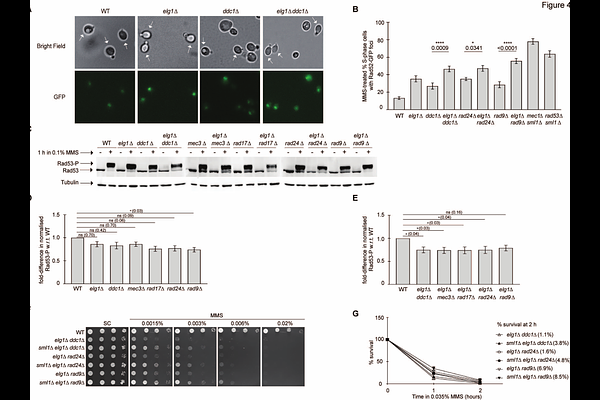The Elg1 Replication Factor C-like complex safeguards cells from replication stress through a noncanonical pathway independent of the Mec1-Rad53 axis

The Elg1 Replication Factor C-like complex safeguards cells from replication stress through a noncanonical pathway independent of the Mec1-Rad53 axis
Bose, P.; Sau, S.
AbstractThe Elg1 Replication Factor C-like complex (Elg1-RLC) that functions as a PCNA unloader, is known to be involved in multiple DNA replication/repair-related activities from yeast to humans. By exploiting disassembly-prone PCNA mutants, we reveal that Elg1-RLC uses its PCNA unloading activity to counter the DNA-alkylating agent methyl-methanesulfonate (MMS)-mediated slow progression of replication forks. Despite having a largely functional DNA Damage Response (DDR), the viability loss of elg1{Delta}-DDR double mutants, in the presence of MMS, matches that of mec1{Delta} and rad53{Delta} cells, deficient for the central checkpoint kinases. This suggests that elg1{Delta}-DDR double mutants experience replication fork collapse when exposed to MMS. Indeed, in response to MMS, accumulation of Rad52 foci in the replicative elg1{Delta}-DDR cells supports this possibility. However, the failure of rescuing elg1{Delta}-DDR mutants by elevating dNTP levels (by deleting the ribonucleotide reductase SML1) eliminates the possibility of a Rad53-regulated dNTP shortage-mediated fork collapse. Thus, we propose a S-phase checkpoint regulatory role of Elg1-RLC that works through a noncanonical pathway parallel to the canonical one. Collectively, our findings suggest a model in which Elg1-RLC, by timely unloading chromatin-bound PCNA from the damaged/stalled forks, coordinates the DDR pathways to safeguard the integrity of replication forks under replication stress.